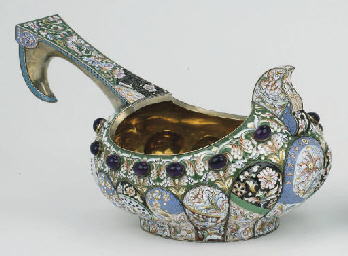Russian Silver Gilt, Cloisonne Enamel and Agate Coffee Pot Workmaster Fedor Ruckert, Moscow, circa 1896-1908 Of baluster form, with tiers of lobed teardrop panels with vari-colored stylized flowers and foliage, the hinged cover with an acorn finial with swirls, workmaster's mark in Cyrillic and stamped 88 and with a kokoshnik mark. Height 8 3/4 inches. Provenance: On loan to the Virginia Museum of Fine Arts, Richmond, Virginia from 1995-2015 Exhibited: Virginia Museum of Fine Arts 1999-2012 A similar coffee pot, part of a three-piece service, is part of the Virginia Museum of Fine Arts, the Jerome and Rita Gans Collection. The same set is illustrated in Gerard Hill, G.G. Smorodinova and B.L. Ulyanova Faberge and the Russian Master Goldsmiths, pl. 211. Enameled silver is one of Russia's greatest artistic legacies. The acknowledged master of this work was Fedor Ruckert (1840-1917), a silversmith of German origin working in Moscow in the final years of Romanov rule. With Russian Nationalism sweeping the Empire in the last half of the 19th century, cloisonne enamel was used to great effect in a mix of foliate and geometric patterns harkening back to antique Russian styles whose brilliance had peaked in the 17th century Byzantine style. Working with enamel requires highly refined skills, and Ruckert's proficient dexterity with enamel is shown in this piece. His use of subtle shading in colors gives added depth and visual interest to the coffee pot. The wirework surrounding the enamel is also used here as a further decorative element, becoming a vibrant gold backdrop for the rich palette of colors. From 1887 until his death in 1917, Ruckert supplied fine pieces to Imperial Russia's most illustrious jewelers including Karl Faberge and Pavel Ovchinnikov among others. Pieces with Ruckert's hallmark are often seen bearing the marks of these other firms as well. It has also been noted by scholars that almost all of the exquisite cloisonne enamels sold by Faberge were made by Ruckert's workshop. C Estate of Harry and Harriet Grandis, Richmond, VA
General discoloration to the silver gilt, both the smooth and braided areas; small chip to the enamel on top of the finial; greenish spot of discoloration on the stone insulator below finial; scattered tiny holes in enamel from the firing process; small gouge (possible mark?) and a diagonal slash along the outer edge of the base
Russian Silver Gilt, Cloisonne Enamel and Agate Coffee Pot Workmaster Fedor Ruckert, Moscow, circa 1896-1908 Of baluster form, with tiers of lobed teardrop panels with vari-colored stylized flowers and foliage, the hinged cover with an acorn finial with swirls, workmaster's mark in Cyrillic and stamped 88 and with a kokoshnik mark. Height 8 3/4 inches. Provenance: On loan to the Virginia Museum of Fine Arts, Richmond, Virginia from 1995-2015 Exhibited: Virginia Museum of Fine Arts 1999-2012 A similar coffee pot, part of a three-piece service, is part of the Virginia Museum of Fine Arts, the Jerome and Rita Gans Collection. The same set is illustrated in Gerard Hill, G.G. Smorodinova and B.L. Ulyanova Faberge and the Russian Master Goldsmiths, pl. 211. Enameled silver is one of Russia's greatest artistic legacies. The acknowledged master of this work was Fedor Ruckert (1840-1917), a silversmith of German origin working in Moscow in the final years of Romanov rule. With Russian Nationalism sweeping the Empire in the last half of the 19th century, cloisonne enamel was used to great effect in a mix of foliate and geometric patterns harkening back to antique Russian styles whose brilliance had peaked in the 17th century Byzantine style. Working with enamel requires highly refined skills, and Ruckert's proficient dexterity with enamel is shown in this piece. His use of subtle shading in colors gives added depth and visual interest to the coffee pot. The wirework surrounding the enamel is also used here as a further decorative element, becoming a vibrant gold backdrop for the rich palette of colors. From 1887 until his death in 1917, Ruckert supplied fine pieces to Imperial Russia's most illustrious jewelers including Karl Faberge and Pavel Ovchinnikov among others. Pieces with Ruckert's hallmark are often seen bearing the marks of these other firms as well. It has also been noted by scholars that almost all of the exquisite cloisonne enamels sold by Faberge were made by Ruckert's workshop. C Estate of Harry and Harriet Grandis, Richmond, VA
General discoloration to the silver gilt, both the smooth and braided areas; small chip to the enamel on top of the finial; greenish spot of discoloration on the stone insulator below finial; scattered tiny holes in enamel from the firing process; small gouge (possible mark?) and a diagonal slash along the outer edge of the base















Testen Sie LotSearch und seine Premium-Features 7 Tage - ohne Kosten!
Lassen Sie sich automatisch über neue Objekte in kommenden Auktionen benachrichtigen.
Suchauftrag anlegen